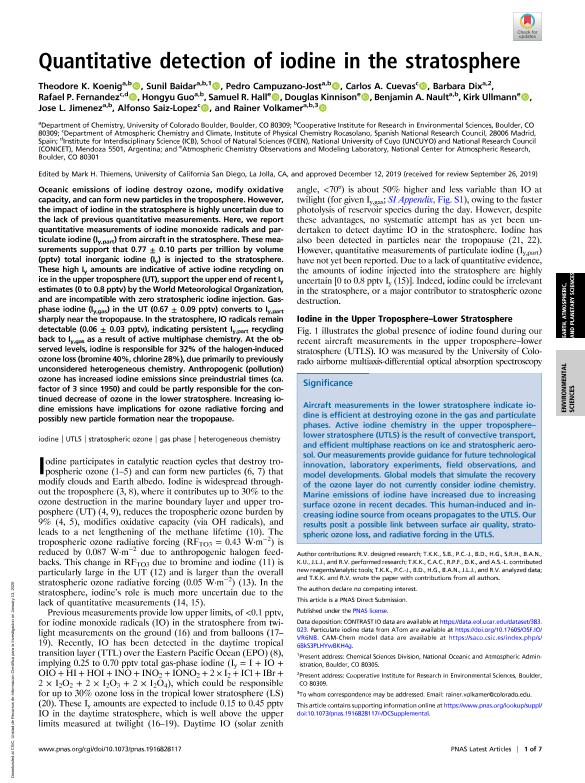Mostrar el registro sencillo del ítem
dc.contributor.author
Koenig, Theodore K.
dc.contributor.author
Baidar, Sunil
dc.contributor.author
Campuzano Jost, Pedro
dc.contributor.author
Cuevas, Carlos Alberto

dc.contributor.author
Dix, Barbara
dc.contributor.author
Fernandez, Rafael Pedro

dc.contributor.author
Guo, Hongyu
dc.contributor.author
Hall, Samuel R.

dc.contributor.author
Kinnison, Douglas
dc.contributor.author
Nault, Benjamin A.
dc.contributor.author
Ullmann, Kirk
dc.contributor.author
Jimenez, Jose L.
dc.contributor.author
Saiz López, Alfonso

dc.contributor.author
Volkamer, Rainer

dc.date.available
2021-09-20T14:29:20Z
dc.date.issued
2020-01
dc.identifier.citation
Koenig, Theodore K.; Baidar, Sunil; Campuzano Jost, Pedro; Cuevas, Carlos Alberto; Dix, Barbara; et al.; Quantitative detection of iodine in the stratosphere; National Academy of Sciences; Proceedings of the National Academy of Sciences of The United States of America; 117; 4; 1-2020; 1860-1866
dc.identifier.issn
0027-8424
dc.identifier.uri
http://hdl.handle.net/11336/140860
dc.description.abstract
Oceanic emissions of iodine destroy ozone, modify oxidative capacity, and can form new particles in the troposphere. However, the impact of iodine in the stratosphere is highly uncertain due to the lack of previous quantitative measurements. Here, we report quantitative measurements of iodine monoxide radicals and particulate iodine (Iy,part) from aircraft in the stratosphere. These measurements support that 0.77 ± 0.10 parts per trillion by volume (pptv) total inorganic iodine (Iy) is injected to the stratosphere. These high Iy amounts are indicative of active iodine recycling on ice in the upper troposphere (UT), support the upper end of recent Iy estimates (0 to 0.8 pptv) by the World Meteorological Organization, and are incompatible with zero stratospheric iodine injection. Gasphase iodine (Iy,gas) in the UT (0.67 ± 0.09 pptv) converts to Iy,part sharply near the tropopause. In the stratosphere, IO radicals remain detectable (0.06 ± 0.03 pptv), indicating persistent Iy,part recycling back to Iy,gas as a result of active multiphase chemistry. At the observed levels, iodine is responsible for 32% of the halogen-induced ozone loss (bromine 40%, chlorine 28%), due primarily to previously unconsidered heterogeneous chemistry. Anthropogenic (pollution) ozone has increased iodine emissions since preindustrial times (ca. factor of 3 since 1950) and could be partly responsible for the continued decrease of ozone in the lower stratosphere. Increasing iodine emissions have implications for ozone radiative forcing and possibly new particle formation near the tropopause.
dc.format
application/pdf
dc.language.iso
eng
dc.publisher
National Academy of Sciences

dc.rights
info:eu-repo/semantics/openAccess
dc.rights.uri
https://creativecommons.org/licenses/by-nc-sa/2.5/ar/
dc.subject
GAS PHASE
dc.subject
HETEROGENEOUS CHEMISTRY
dc.subject
IODINE
dc.subject
STRATOSPHERIC OZONE
dc.subject
UTLS
dc.subject.classification
Investigación Climatológica

dc.subject.classification
Ciencias de la Tierra y relacionadas con el Medio Ambiente

dc.subject.classification
CIENCIAS NATURALES Y EXACTAS

dc.title
Quantitative detection of iodine in the stratosphere
dc.type
info:eu-repo/semantics/article
dc.type
info:ar-repo/semantics/artículo
dc.type
info:eu-repo/semantics/publishedVersion
dc.date.updated
2021-08-25T19:28:56Z
dc.journal.volume
117
dc.journal.number
4
dc.journal.pagination
1860-1866
dc.journal.pais
Estados Unidos

dc.journal.ciudad
Washington
dc.description.fil
Fil: Koenig, Theodore K.. State University of Colorado at Boulder; Estados Unidos
dc.description.fil
Fil: Baidar, Sunil. State University of Colorado at Boulder; Estados Unidos
dc.description.fil
Fil: Campuzano Jost, Pedro. State University of Colorado at Boulder; Estados Unidos
dc.description.fil
Fil: Cuevas, Carlos Alberto. Consejo Superior de Investigaciones Científicas. Instituto de Química Física; España
dc.description.fil
Fil: Dix, Barbara. State University of Colorado at Boulder; Estados Unidos
dc.description.fil
Fil: Fernandez, Rafael Pedro. Consejo Superior de Investigaciones Científicas. Instituto de Química Física; España. Consejo Nacional de Investigaciones Científicas y Técnicas. Centro Científico Tecnológico Conicet - Mendoza. Instituto Interdisciplinario de Ciencias Básicas. - Universidad Nacional de Cuyo. Instituto Interdisciplinario de Ciencias Básicas; Argentina
dc.description.fil
Fil: Guo, Hongyu. State University of Colorado at Boulder; Estados Unidos
dc.description.fil
Fil: Hall, Samuel R.. National Center for Atmospheric Research; Estados Unidos
dc.description.fil
Fil: Kinnison, Douglas. National Center for Atmospheric Research; Estados Unidos
dc.description.fil
Fil: Nault, Benjamin A.. State University of Colorado at Boulder; Estados Unidos
dc.description.fil
Fil: Ullmann, Kirk. National Center for Atmospheric Research; Estados Unidos
dc.description.fil
Fil: Jimenez, Jose L.. State University of Colorado at Boulder; Estados Unidos
dc.description.fil
Fil: Saiz López, Alfonso. Consejo Superior de Investigaciones Científicas. Instituto de Química Física; España
dc.description.fil
Fil: Volkamer, Rainer. State University of Colorado at Boulder; Estados Unidos
dc.journal.title
Proceedings of the National Academy of Sciences of The United States of America

dc.relation.alternativeid
info:eu-repo/semantics/altIdentifier/url/http://www.pnas.org/lookup/doi/10.1073/pnas.1916828117
dc.relation.alternativeid
info:eu-repo/semantics/altIdentifier/doi/http://dx.doi.org/10.1073/pnas.1916828117
Archivos asociados
